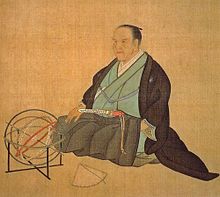Ōshio Heihachirō
Ōshio Heihachirō ( Japanese 大 塩 平 八郎 ; born March 4, 1793 in Osaka ?; Died May 1, 1837 ) was a Japanese neo-Confucianist and idealist.
Live and act
Ōshio Heihachirō's origin is unknown. As a teenager, he attended a training course to become a kind of police officer under the shogunate. He also began studying Neo-Confucianism, eventually focusing on the ideas of Wang Yangmin , the Yōmei doctrine (陽明 学). This led to a commitment to a justice of the people.
In 1830 Ōshio retired from civil service and founded a school called Senshindō (洗 心 洞), in which he taught the ideas of Wang. He published his subject matter in 1833 as "Senshindō satsuki" (洗 心 洞 さ 付). Ōshio's theme was that the rich and high-ranking people determined the law, not in accordance with the timeless ideals of goodness, but based on social status.
In 1835 and 1836 there was a great famine in the Kansai area due to poor harvests, which - with reference to the currently valid era name - went down in history as the "Tempō Famine" (天保 飢饉, Tempō Kikin). After shio had unsuccessfully asked the government for help, he called on the rural population and the poor townspeople to revolt against injustice and oppression. On February 19, 1837, Ōshio attacked government buildings and set fire to parts of Osaka in the hope of sparking a general uprising there. A neighborhood of Osaka, including government warehouses, was devastated in two days of chaos and fire.
The uprising was suppressed, Ōshio, brought by the government troops, took his own life. His son Chūsai (中 斎) also committed suicide. Both are buried at the Jōshō-ji (常 照 寺) temple in Osaka.
Individual evidence
literature
- S. Noma (Ed.): Ōshio Heihachirō . In: Japan. An Illustrated Encyclopedia. Kodansha, 1993, ISBN 4-06-205938-X , p. 1168.
| personal data | |
|---|---|
| SURNAME | Ōshio, Heihachirō |
| ALTERNATIVE NAMES | 大 塩 平 八郎 (Japanese) |
| BRIEF DESCRIPTION | Japanese Neo-Confucianist |
| DATE OF BIRTH | March 4, 1793 |
| PLACE OF BIRTH | Osaka ? |
| DATE OF DEATH | May 1, 1837 |
| Place of death | Osaka |

